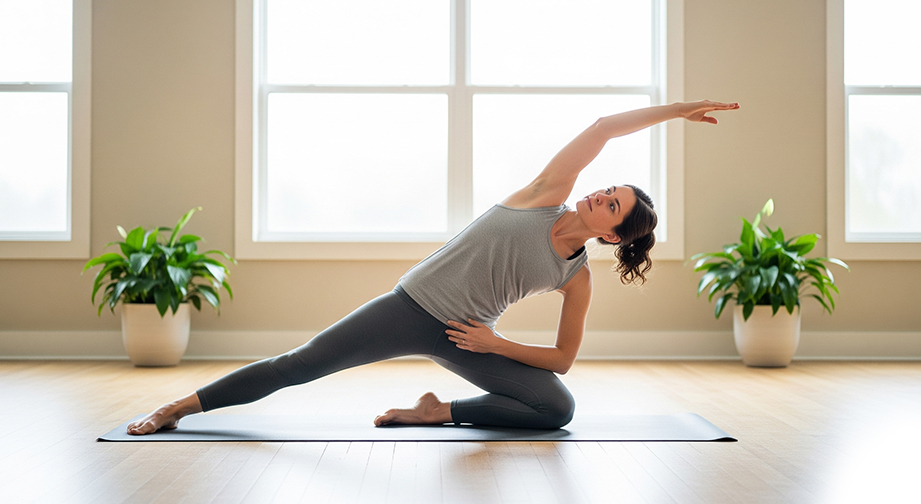Parighasana (Gate Pose) – A Beginner’s Guide to Unlocking Side Body Freedom
Introduction
Parighasana, known in English as Gate Pose or Gate Standing Pose, is a gentle side-bending yoga asana that helps you stretch and wake up your whole body. The Sanskrit word "Parigha" means "gate latch" or "bar," representing how your body forms the shape of a closing gate.
Essence: Balancing & Expansive – Parighasana opens the side body, bringing both energy and relaxation.
Beginner's Hook: If you've ever felt tight or stiff after a long day at your desk, Gate Pose is your best friend for releasing that tension and bringing in fresh movement.
Step-by-Step Guide to Parighasana (Gate Pose)

- Start in a kneeling position with your thighs and torso upright. Place your hands on your hips.
- Extend your right leg out to the side, straightening it (foot flat, toes facing forward or slightly up). Keep your left knee under your left hip.
Inhale: Lengthen your spine upwards.
- Raise your arms. Stretch both arms out to the sides at shoulder height, palms facing down.
Exhale: Relax your shoulders away from your ears.
- Side bend to the right. Slide your right hand down your right leg, reaching towards your shin or ankle. At the same time, sweep your left arm overhead, creating a long curve on the left side of your body.
Inhale: Reach through the left fingertips.
- Maintain the pose for 3–6 breaths, deep and steady.
Exhale: Soften into the side stretch each time you breathe out.
- Return to center as you inhale. Bring arms to sides and slide right leg back to kneeling.
Switch sides and repeat.
- Duration: Hold for 20–30 seconds each side; repeat 1–2 rounds per side.
Modifications & Intensifications
- For Beginners: Place a block under your right hand for support, or keep your left hand on your hip.
- For Advanced: With the top arm, reach even further over the ear. Try interlacing the fingers behind your head and extend the elbow back.
Alignment & Safety Tips
- Keep hips facing forward (don't let them twist).
- Top arm long, not collapsing forward—shoulder in line with the ear.
- Knee under hip; don't let the knee splay out or cave in.
- Press the foot of the extended leg firmly into the floor.
Common Mistakes to Avoid:
- Collapsing chest or torso—maintain open side body.
- Bending the extended knee—keep the leg active.
- Over-reaching without breath—move only within a pain-free range.
- Avoid Parighasana if you have knee injuries, severe hip pain, or balance difficulties.
- If pregnant, use extra support (blanket or bolster) and do not force the side-bending motion.
Benefits of Parighasana (Gate Pose)
Physical Benefits
- Stretches side body (obliques, intercostal muscles, and lats)
- Increases flexibility in spine, hips, and hamstrings
- Improves posture and breath capacity
- Gentle core activation
Mental Benefits
- Relieves tension & stress
- Promotes mindfulness and present-moment awareness
- Calms the mind while energizing the body
Energy/Chakra Connection
- Activates Anahata (heart) and Manipura (solar plexus) chakras, aiding open-heartedness and personal power
- Stimulates prana (energy) flow along the side channels (nadis)
Contraindications
- Knee injuries, recent hip replacement, severe lower back pain
- Balance disorders or dizziness
- Pregnancy—avoid deep bending and use wall support
Safe alternatives:
- Seated Side Bend (Parsva Upavistha Konasana) as a gentler option
- Supported Side Stretch (with bolster or chair)
Beginner’s Tips & Variations
- Props: Place a block under your bottom hand for stability. Use a folded blanket under the kneeling knee.
- Gentle Variation: Keep the top hand on your hip. Don’t reach as far; focus on a mild stretch.
- Advanced: Bind the top arm behind the back, or reach both arms over your head for greater intensity.
How to Include Parighasana in a Yoga Flow
- Best used as a middle or warm-up pose; great for gently preparing the body for deeper twists and side bends.
- Pairs well with:
- Adho Mukha Svanasana (Downward Dog)
- Utthita Parsvakonasana (Extended Side Angle Pose)
- Ustrasana (Camel Pose)
Mind-Body Connection
As you move into Parighasana, bring your awareness to the gentle movement of breath along your expanded side. Notice any sensations, and invite softness with every exhale. This posture invites a feeling of spaciousness—both within your body and your mind.
Parighasana’s energizing opening is often seen as expanding the heart (Anahata chakra), cultivating receptivity and compassion.
Summary Box
- Asana Name: Parighasana (Gate Pose / Gate Standing Pose)
- Focus Areas: Side body, hips, hamstrings, spine
- Duration: 20–30 seconds per side; 1–2 rounds
- Best Time to Practice: Morning or early evening
Frequently Asked Questions (FAQs)
- Can I do Parighasana if I have tight hamstrings? Yes! Keep the extended leg slightly bent or use a block for support.
- What if kneeling hurts my knee? Place a folded blanket or cushion under your kneeling knee for extra comfort.
- Is Gate Pose good for beginners? Absolutely. It is gentle, adjustable, and ideal for all levels.
- Can Parighasana help with back pain? Yes, gently—provided you’re cleared by your healthcare provider and avoid pushing past comfortable limits.